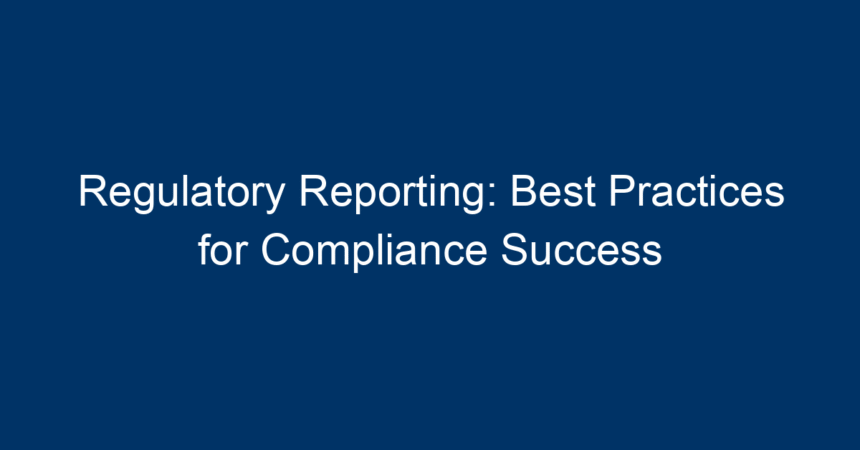In today’s fast-paced and ever-evolving business landscape, regulatory reporting has emerged as a vital function for organizations across various sectors. From financial services to healthcare, adherence to regulatory standards isn’t just about avoiding penalties; it’s about building trust and maintaining a competitive edge. This article delves into the best practices for regulatory reporting that not only help companies achieve compliance but also streamline their processes for long-term success.
Understanding Regulatory Reporting
Before diving into best practices, it’s essential to understand what regulatory reporting entails. Regulatory reporting involves the submission of financial, operational, and compliance-related information to regulatory authorities. The objective is to provide transparency, ensure accountability, and safeguard the interests of stakeholders. Common regulations that necessitate reporting include the Sarbanes-Oxley Act (SOX), the Dodd-Frank Act, and Basel III among others.
Why Regulatory Reporting Matters
Regulatory reporting is critical for several reasons:
- Risk Management: It helps organizations identify potential financial and operational risks early.
- Regulatory Compliance: Adhering to reporting standards keeps businesses in good standing with regulatory bodies.
- Reputation Management: Consistent and accurate reports build trust with customers, investors, and regulators.
Understanding the significance of regulatory reporting is the first step toward establishing effective practices for compliance success.
Best Practices for Effective Regulatory Reporting
1. Establish a Clear Reporting Framework
A robust framework serves as the foundation for effective regulatory reporting. This framework should include:
- Defined Objectives: Clearly outline the goals of your reporting, including the specific regulations to be adhered to.
- Roles and Responsibilities: Assign tasks to ensure accountability within your teams.
- Standard Operating Procedures (SOPs): Develop SOPs that detail each step of the reporting process.
2. Leverage Technology for Automation
Incorporating technology—such as regulatory reporting software—can significantly enhance accuracy and efficiency. Benefits include:
- Data Integrity: Automated systems minimize the risk of human error, ensuring your data is consistent and reliable.
- Real-Time Updates: Keeping software up to date with the latest regulatory changes ensures compliance is never compromised.
- Reporting Templates: Many software solutions offer pre-built templates based on regulatory requirements, saving time and effort.
3. Ensure Data Accuracy and Consistency
Data quality is the lifeblood of regulatory reporting. To ensure accuracy, consider the following steps:
- Regular Data Audits: Periodically review your data for inconsistencies or inaccuracies.
- Establish a Data Governance Program: Implement protocols that govern data collection, storage, and usage.
- Train Staff Regularly: Initiate ongoing training sessions to keep staff updated on data management best practices.
4. Maintain Open Lines of Communication
Effective communication is crucial for successful regulatory reporting. Here’s how you can facilitate this:
- Cross-Departmental Collaboration: Ensure that different departments—such as finance, compliance, and IT—are aligned in their understanding of reporting requirements.
- Feedback Mechanism: Create channels for feedback to continuously improve reporting processes.
- Regular Meetings: Schedule regular check-ins to discuss regulatory updates and review reporting practices.
5. Focus on Continuous Improvement
Regulatory environments are constantly evolving, and your reporting processes should adapt accordingly. To foster a culture of continuous improvement:
- Monitor Regulatory Changes: Stay updated on new laws and amendments that may impact your reporting obligations.
- Solicit External Audits: Engage third-party experts to evaluate your reporting practices and provide recommendations for improvement.
- Implement KPIs: Establish Key Performance Indicators (KPIs) that measure the effectiveness of your reporting processes.
Overcoming Challenges in Regulatory Reporting
While the best practices outlined above can pave the way for compliance success, organizations often encounter challenges. Here are a few common obstacles and strategies to overcome them:
Keeping Up with Regulatory Changes
Regulations can change with little notice. Establishing a regulatory radar—tools and resources to monitor changes—can help your organization stay ahead.
Resource Constraints
Many companies struggle with limited resources when it comes to compliance. Prioritize investments in technology that streamline reporting and use cloud solutions for scalability and cost-effectiveness.
Data Management Issues
Poor data management can derail your regulatory reporting efforts. Implementing a strong data governance framework will help streamline data collection, storage, and validation.
Conclusion: Taking Action for Compliance Success
Regulatory reporting is an essential element of organizational integrity and success. By establishing a clear framework, leveraging technology, ensuring data accuracy, maintaining open lines of communication, and focusing on continuous improvement, organizations can navigate the complex landscape of regulatory compliance with confidence.
Actionable Insights
- Audit Your Current Reporting Practices: Assess your existing processes to identify strengths and areas for improvement.
- Invest in Training: Ensure your team is well-versed in regulatory requirements and data management practices.
- Engage Technology: Consider utilizing advanced regulatory reporting software that aligns with your compliance needs.
- Stay Informed: Sign up for industry newsletters and join relevant professional networks to keep up with regulatory changes.
- Set Up Regular Reviews: Schedule quarterly reviews of your compliance practices to adapt to evolving regulations effectively.
With these actionable insights and best practices, organizations can not only achieve regulatory compliance but also set the stage for ongoing success in a competitive landscape. As the regulatory environment continues to evolve, being proactive in your reporting strategy will pay dividends in the long run.




